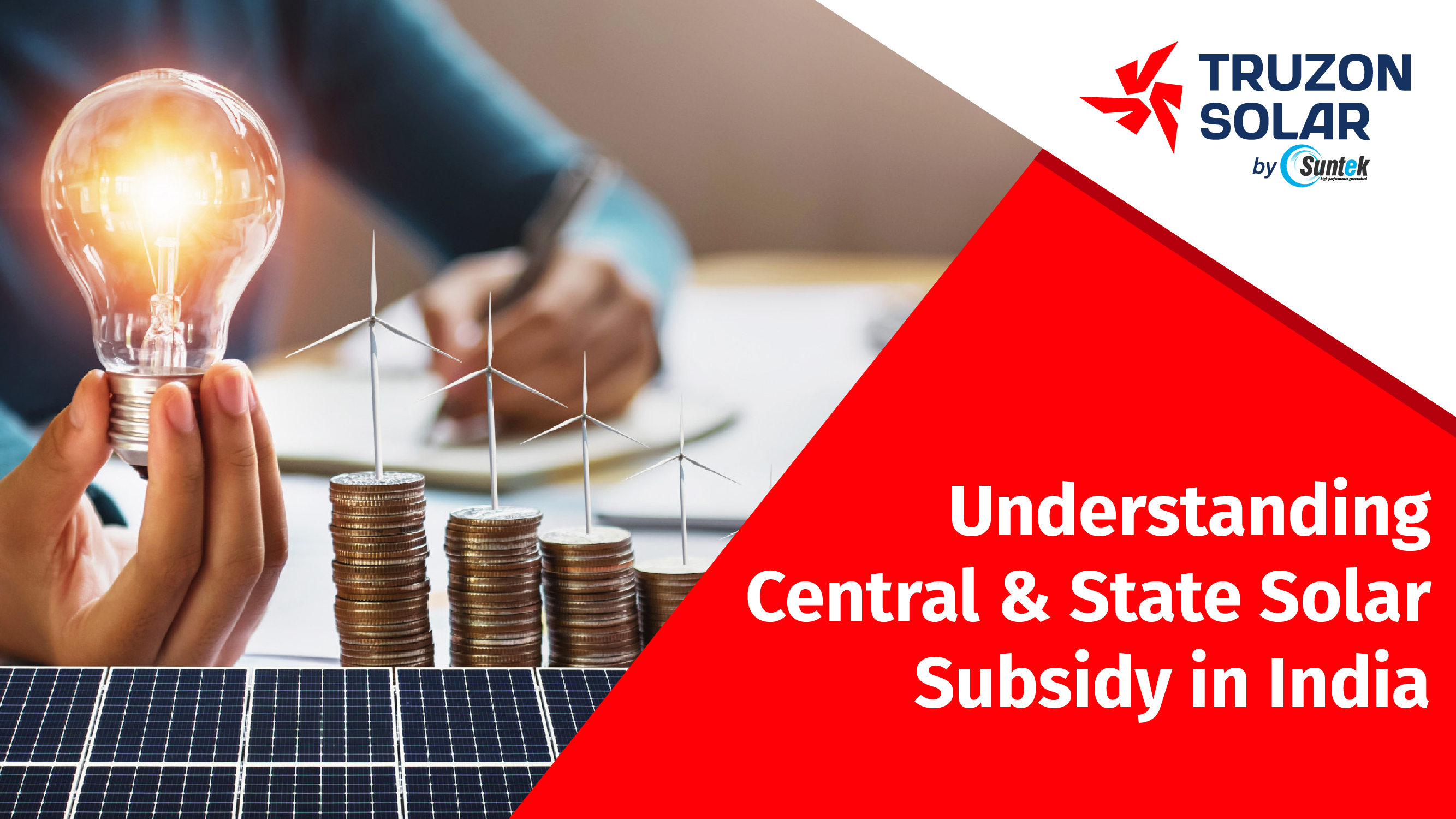- Refer & Earn
- Get Expert Suggestion
- Download Brochure
Welcome to Truzon Solar
We provide the best solar solutions for your home.
Understanding Central & State Solar Subsidy in India

Over the last few years, India has seen a massive surge in the adoption of solar energy and is continuing to do so. It is aiming to reach an ambitious target of 500 GW of non-fossil fuel-based energy capacity by 2030. Right from vast ground-mounted solar plants (76.95 GW) to rooftop systems (16.28 GW), hybrid setups (2.85 GW), and off-grid installations (4.25 GW), solar is lighting up homes, factories, and communities across the country.
Not only this, a key motivator has been the subsidies offered by state and central governments, which have lowered the solar panel installation costs subsequently.
Who Can Avail the Solar Subsidy?
The Central Financial Assistance (CFA) for solar panel installation is available for residential consumers who have grid-connected rooftop solar systems. For group housing societies and RWAs, the eligibility criteria are having systems up to 500kW to benefit from this incentive.
If you have adequate roof space, you are eligible to install solar panels. And those with limited space can explore installation on terraces, balconies, or elevated structures.
Central Financial Assistance (CFA)
CFA was launched under the Rooftop Solar Programme Phase II at the end of 2022 and is spearheaded by the MNRE. It was implemented via DISCOMs and state agencies.
Under the Direct Benefit Transfer (DBT) system, consumers can receive the subsidy directly in their bank accounts, thus streamlining the process and enhancing transparency.
The CFA has made subsidy calculation simple and fair, offering uniform benefits across states, with added advantages for northeastern states and select union territories.
Types of Solar Panel Subsidies in India
There are two subsidy options to make solar panel installation more affordable:
- ● Central Government Subsidy: It is offered by the Ministry of New and Renewable Energy (MNRE).
- ● State Government Subsidy: Additional financial support from individual state governments is offered, based on their renewable energy policies.
Central Government Solar Panel Subsidy
Through schemes like the Pradhan Mantri Surya Ghar Yojana and the National Rooftop Solar Programme, the central government covers a portion of installation costs, enabling households to switch to clean energy more easily.
State-Wise Solar Subsidies
Apart from central support, each state offers its own subsidies:
| State | Solar Panel Subsidy Highlights |
|---|---|
| Maharashtra | Additional 10% subsidy on rooftop installations; Net metering available |
| Gujarat | 40% subsidy up to 3 kW systems; 20% for larger ones |
| Rajasthan | Extra rebates on electricity bills for solar users |
| Tamil Nadu & Karnataka | Incentives offered through state energy agencies |
Homeowners should consult their local DISCOM for the latest state-specific guidelines.
Solar Panel Subsidy Eligibility for Residential & Commercial Users
- ● Residential Users are eligible for solar panel subsidies of 30% to 40% of the installation cost.
- ● Commercial & Industrial Users don’t receive direct solar panel subsidies, but they can benefit from tax incentives, accelerated depreciation, and net metering options.
PM Surya Ghar Muft Bijli Yojana
This scheme aims to provide free electricity up to 300 units per month for eligible households.
Eligibility Criteria to Avail Solar Panel Subsidy:
- ● Must be a residential consumer
- ● Must have rooftop space available
- ● Installation must be done by an MNRE-approved vendor
Solar Panel Subsidy Amounts:
| Solar System Size | Subsidy Amount |
|---|---|
| Up to 3 kW | ₹18,000 per kW |
| 3 kW – 10 kW | ₹9,000 per kW |
| Above 10 kW | ₹1,17,000 (fixed amount) |
India's Rooftop Solar Journey: Progress & Potential
In 2015, Prime Minister Narendra Modi raised India’s solar ambition by announcing a bold target of 100 GW installed solar capacity by 2022, which is a fivefold increase from the earlier 20 GW goal. Of that, 40 GW was for rooftop solar systems, highlighting a bold move towards decentralized clean energy.
To achieve this, both central and state governments have rolled out numerous solar panel subsidy policies, financial incentives, and support schemes; to further support, states have also introduced customized solar panel subsidy policies and net metering regulations.
Segment-Wise Contribution to 1 GW Rooftop Capacity:
- ● Industrial: 40%
- ● Residential: 25%
- ● Commercial: 25%
- ● Government Buildings: 10%
Installation Models:
- ● Capex (ownership by consumer): 85%
- ● Opex (third-party ownership): 15%
Truzon Solar, with 16+ years of industry experience and more than 20000+ satisfied customers, offers you top-notch solar installation services for residential and commercial setups. From site planning to seamless setup, we deliver reliable, high-efficiency solutions tailored for long-term performance. Plus, with government-backed solar subsidies under schemes like the PM Surya Ghar: Muft Bijli Yojana, switching to solar is now more affordable than ever. Choose Truzon Solar and take a step toward a greener, smarter tomorrow.
FAQ
1. Who can avail of a solar panel subsidy in India?
Solar panel subsidies are rolled out by the state and central government to provide incentives for the installation of household solar systems. To avail a solar panel subsidy in India, one must be an Indian resident and have an open rooftop space to install the panels.
2. How much subsidy is sanctioned under the PM Surya Ghar Muft Bijli Yojana?
The subsidy amount under PM Surya Ghar Muft Bijli Yojana is sanctioned at a maximum cap of INR 78000.
3. How can one apply for the PM Surya Ghar Muft Bijli Yojana?
Visit the official website of PM Surya Ghar Muft Bijli Yojana and click on Apply for rooftop solar to start your application.


.png)


